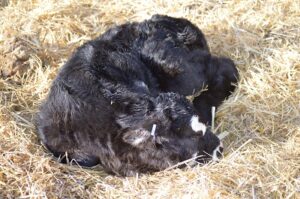Dealing with Dehydrated Calves – When and How to Use Electrolytes
Remarque : cette page web n’est actuellement disponible qu’en anglais.

The following is the final articles in a series of three posts featuring calving management practices and intervention strategies to help producers optimize newborn calf health and well-being. Read part one to learn about resuscitation techniques and part two about colostrum.Supplementing young calves with electrolytes is sometimes necessary. Electrolytes are given to calves showing signs of dehydration, usually due to scours. In the case of calf scours, most calves that die from scours don’t actually succumb to the virus or bacteria causing the symptoms, but rather die from dehydration. Adequately rehydrating calves when they are sick is key for calf survival. Here are a few things to remember when rehydrating calves:
- Stick two fingers in a calf’s mouth to see if it will suck. If a calf still has a suckle reflex they are probably only mildly dehydrated and can be revived with oral electrolytes.
- If a calf is more severely dehydrated, they will be unable to stand and their eyes will be sunken in. If this is the case, they are in need of veterinary intervention and IV fluids.
- Ensure electrolyte solutions include salt, potassium, an energy source like glucose, and amino acids like glycine or alanine. This will ensure the product is doing its job to effectively rehydrate the calf. Your veterinarian can help you choose an electrolyte product that will work for you.
- Have a separately marked bottle for electrolytes and medicines and a separate bottle for colostrum. Avoid using bottles or tubes interchangeably and make sure to clean and disinfect feeding equipment after each use.
- Talk to your veterinarian about a protocol for feeding oral electrolytes as the amount needed will change depending on how dehydrated the calf is. Continue giving electrolytes until the calf has stopped scouring, even if they look like they have recovered, because they still have the potential to be dehydrated.
Producers have invested a lot of money into a newborn calf by the time it hits the ground. Once calves have arrived, ensuring they are healthy or treating them for dehydration when necessary will help them thrive and grow. For more information visit our Calving and Calf Management webpage.
Click here to subscribe to the BCRC Blog and receive email notifications when new content is posted.
The sharing or reprinting of BCRC Blog articles is welcome and encouraged. Please provide acknowledgement to the Beef Cattle Research Council, list the website address, www.BeefResearch.ca, and let us know you chose to share the article by emailing us at info@beefresearch.ca.
We welcome your questions, comments and suggestions. Contact us directly or generate public discussion by posting your thoughts below.